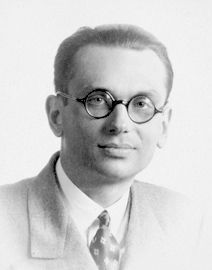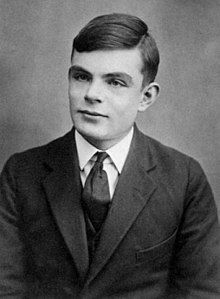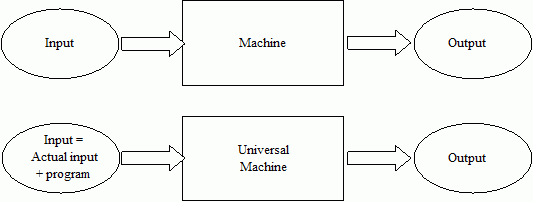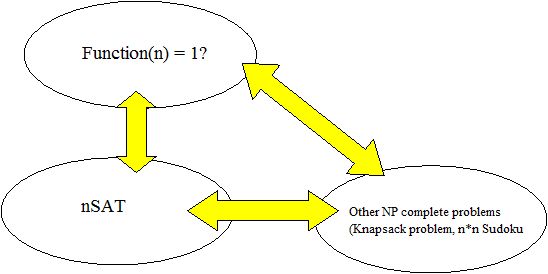Knowable and Unknowable for
Universal machines and Humans
Gerard Westendorp, 2019

My
website is
moving. Best
go to the
new location at
westy31.nl
This
old page will be gone soon...
Home
Sorry for the bombastic title, but it sounds cool.
I just wrote an article, now trying to get it on the ArXiv, called
"Internally Uncomputable
functions, with application to the P versus NP problem". If
the
article is correct, it would solve "P versus NP", an important
open problem . Of course, I realize many people have already
claimed this
before, and till now they were all wrong. Actually, my proof is at this
moment probably incomplete, but hoprfully still an interseting approach.
This web page is an informal explanation about the problem, and what I
wrote about it. Here is a pdf of
the
article.
History
In 1900, David Hilbert was probably the most famous mathematician of
his time. A new century had just begun. He did not know yet that it
would bring 2 world wars, and a huge increase in scientific knowledge.
But as for mathematics, he made a good guess about what would be
important: Hilbert's 23 problems.




 Hilbert, Gödel,
Church, Turing and Radó.
Hilbert, Gödel,
Church, Turing and Radó.
Hilbert's 2nd problem (after it was reformulated a bit more carefully)
became known as the "Entsheidingsproblem".
It asks:
"Can all of mathematics be formulated in terms of fixed axioms, and
fixed derivation rules, so that all mathematical truths can be either
proven or disproven using these rules?"
"Can we exclude that something is both provable but its converse is
also provable? (ie: can we be sure mathematics is consistent?)"
"Entscheidung"
means "distinguish`,
in
the sense of dividing everything into "TRUE"
and "FALSE".
(Note: Hilbert was not the first to ask this question, it was already
asked by Leibniz in the 17th century)
This problem is obviously of great interest philosophically. It seems
to tell us something important about thought itself. But is it true?
Well, to everyone's shock, in 1935, Kurt Gödel proved
that it
was false!
Besides TRUE and FALSE, there are certain propositions that are
UNDECIDABLE.
Also, mathematics might be consistent, but that cannot be proven within
mathematics. And Gödel could prove that it could not
be
proven!
What can we make of this? One problem was
that Gödel's
article was quite difficult for those untrained in the language of
mathematical logic. Nevertheless, as with most good ideas, the basic
idea is actually simple, but subtle. Douglas Hofstadter
explains it in
his book "Gödel, Escher, Bach".
Gödel's idea was greatly clarified in 1936 by Alan Turing. In
the
same article, Turing also explained all the basic ideas behind the
"Universal machine", now better known as the computer. I am skipping
the work of Alonso Church here, but many of Turing's ideas were
partially preceded and influenced by Church and others, like
Kleene.
However, the great advantage of Turing's approach, is that it is much
easier to understand than Godel and Church. Why? Because it can be
expressed in terms of things that a computer does. That is much easier
to visualize, especially for us in the 21rst century.
If you break down mathematical reasoning, at the lowest level it seems
come down to applying a fixed set of rules. These rules are so
unambiguous, that they could be done by a machine. So Turing
thought: What if they are
done by a machine? First he described how you could build a Universal
machine, one that could simulate any other machine, by adding some
extra data: what we now call a "stored program". Then, he showed that
there are problems that such a machine cannot decide. One such problem
is the Halting problem. It asks for a general procedure for determining
if some other programs ever stops (Halts), or goes on forever. For some
programs, this is easy to see. But in more complex cases, it gets very
difficult. In fact impossible, as Turing showed.
If a Universal machine cannot compute something, then mathematical
logic cannot prove that thing, and we humans cannot know if it is true.
How can we know a universal
machine exists?
First, we can think about universal
data. It is very hard,
perhaps impossible, to think of anything
in our world that cannot be expressed as a set of numbers. Written text
can be converted to numbers, by numbering the characters of the
alphabet. Pictures can be turned into numbers by turning them into a
bitmap; each pixel is given a value for red, blue and green. Sound can
be turned into numbers by specifying the sound pressure for each time
step. Physical systems can be turned into numbers by specifying
velocities, positions, field strengths, etc.
Note that there is one assumption I brushed over: We have to
first
discetise things. Well, text is already discrete, but a picture for
example could in principle have an infinite number of pixels per area.
We assume that very small details become unimportant. Is that true?
Here is what Turing wrote about it in 1936:
It
will seem that given the initial state of the machine and the input
signals it is always possible to predict all future states, This is
reminiscent of Laplace's view that from the complete state of the
universe at one moment of time, as described by the positions and
velocities of all particles, it should be possible to predict all
future states. The prediction which we are considering is, however,
rather nearer to practicability than that considered by Laplace. The
system of the "universe as a whole" is such that quite small errors in
the initial conditions can have an overwhelming effect at a later time.
The displacement of a single electron by a billionth of a centimeter at
one moment might make the difference between a man being killed by an
avalanche a year later, or escaping. It is an essential property of the
mechanical systems which we have called "discrete-state machines" that
this phenomenon does not occur. Even when we consider the actual
physical machines instead of the idealized machines, reasonably
accurate knowledge of the state at one moment yields reasonably
accurate knowledge any number of steps later.
OK, we are not sure the universe is ultimately discrete. But if we will
just
concentrate on discrete systems for now. We can go one step further
down the
reduction ladder: From numbers to bits. Any number can be written as a
bunch of "1" and "0" symbols, ore equivalently "TRUE" and "FALSE".
Welcome to the digital age!
Now a universal machine has to be able to convert any set of bits to
another set of bits.
Consider a digital machine as a black box. In go M
bits, out go N bits.
We can split the problem of building a universal machine for this, by
doing it one output bit at a time. Often not efficient, but
conceptually easier to understand. So how can we make any 1-output bit
function of M input
bits?
Well, we could just make a list of all the
combinations of the M
bits
for which the output is TRUE, and otherwise,
leave it FALSE. In other words, we write down a Truth table. For
example:
A AND (NOT(B)) AND
E
OR B AND (NOT(C))
OR A AND E
OR .....
A,B,C,...
are the names of
the input variables.
Each row is composed of variables, tied together with NOT and AND.
The Consecutive rows can be glued together with OR.
So the only functions on bits that the machine needs are NOT, AND and
OR.
To be even more minimalistic, all 3 of these can be made from the
function NAND (Not AND):
NOT(x)
= NAND(x,x)
AND(x,y) = NAND((NAND(x,y),(NAND(x,y))
OR(x,y) = NAND((NAND(x,x),(NAND(y,y))
In addition to calculating these functions, the universal machine has
to be able to read and write to memory. In Turing's original machine,
this was done by moving a tape, on which the symbols could be read
and/or printed. But let's take advantage of more modern architecture,
and just assume that you can do READ(Address), and WRITE(Address).
Ultra-minimalistic Turing machines tend to be more tricky to understand.
If a machine can READ(Address), WRITE(Address), do a
NAND
function, it can in principle do anything. Now we are ready for the
final step. Give these basic instructions a code number. Then, write
down the sequence of instructions you want the machine to do as a
sequence of these numbers: the "Program". If we can build a machine
that can read a program instructions, and then execute the instruction,
and move to the next program instruction, we have a universal machine!
What about machines that have multiple simultaneous processors, or
quantum computers? Well, these can be simulated by a universal Turing
machine, although sometimes at high computational cost.
 A
universal Universal machine can
simulate any other machine, by adding the "program" of the other
machine to the original input.
A
universal Universal machine can
simulate any other machine, by adding the "program" of the other
machine to the original input.
Things a Universal machine
cannot do, and its implications for
humans and mathematics.
A Universal machine can simulate logical reasoning
and vice
versa.
So if has a Universal machine has a problem that it cannot solve, then
this means mathematics itself has a problem it can't solve.
A Universal machine can simulate human reasoning and vice
versa.
So if has a Universal machine has a problem that it cannot solve, then
this means humans have a problem they can't solve.
(I know not everybody agrees with that)
Turing's original argument showing that a machine cannot decide its own
halting problem, goes roughly like this:
Suppose there is a program H,
that inspects the program of some other program, and after analyzing
it, outputs "1" if it halts, and "0" if not. The you can then construct
a program H2,
that is
specifically designed to fool H.
It creates a copy of itself, then uses the code of H
(which is "public"), to see if H
would think if it halts. Then it
does the opposite. it is actually a bit tricky, though possible, to
give the code of H2
to H,
including the intention of H2 to
do the opposite H
thinks it will do. But even that
information cannot help H.
What is the big advantage of H2
over H?
That H
claims to exist, and
be capable some very difficult things, while H2
claims only to exist if
H
exist.
Here is an analogy:
Imagine there is an App on your smart phone that claims it can predict
what people will do. You want to know if someone will go left or right,
you ask your App, and it will tell you. But now, you ask the App what you
will do. It answers "left". At
that moment, you seem to have "free will", you could decide to do the
opposite. Does that prove free will exists? No, it proves that the App
cannot exist. By "Free will" I mean something outside the laws of
physics, that we humans might possess, that enables us to make choices
that cannot be predicted by by any super smart entity.
I call programs like H and
the above App, internal
programs. They are themselves part of the system. As such, they are
accessible to other internal programs, which can then outsmart them.
Given a finite machine (M1), an external
program is a program on machine (M2) sufficiently bigger than M1, that
is able to simulate M1. For M2, everything on M1 is completely known.
M2 knows if M1 can prove something true, false, or if it cannot decide.
It also knows with certainty what all programs on M1 will do. And this
time, the programs on M1 cannot make use of the services of M2, because
it is too big.
In the analogy to humans: The Gods know what we are going to
do,
but we cannot implement The Gods on an App, because they are too big.
The Gods are external to our universe, the app is internal.
The distinction between internal and external programs is the "secret
weapon" I used to prove P is not NP.
P versus NP
Have you ever had an "AHA moment"? Suddenly, you see a solution to a
problem that had been bothering you for some time. Well, that means
your problem was in complexity class NP. The "AHA" solution was verifiable
in a short time. But finding
it was hard. The P versus
NP problem asks if there is a "Eureka generator": An efficient
procedure for finding a solution assuming that the solution is quickly
verifiable.
If the input of the problem has N
bits, then there is a "brute force" method for solving it: Try all
combinations. This will take an amount of time that is proportional to 2N.
It takes "exponential
time", which means in practice an extremely long time. Try doing a
Sudoku by trying all number combinations...
P stands for Polynomial time, which means essentially faster than
exponential; it does something smarter than simply trying all
possibilities.
NP stands for Non Deterministic Polynomial Time, which
means the
problem can be solved by "guess and verify".
 Venn
diagram of complexity classes P
and NP.
Venn
diagram of complexity classes P
and NP.
 All
NP complete problems are related,
they can be transformed into one another. If one would be in P they all
are.
All
NP complete problems are related,
they can be transformed into one another. If one would be in P they all
are.
So what did I do?
First, I prove the "bounded time halting theorem". This is like the
halting theorem, but now we ask if programs stop in time <T,
rather than in unbounded time.
This can be decided by a program that is allowed a time sufficiently
longer than T:
It could simulate the program in
question, and see if it halts I call this an external
program. But I prove it
cannot be decided by an internal
program that itself can
only use time <T.
This makes undecidability a bit less mysterious. It comes from the fact
that you can run out of time trying to find some solution. You can
increase the time, but the problems can then also increase in
complexity. The solvers are always behind on the problem
generators.
Then I look at the NP-complete problem of finding a solution to f(N1)
=1. N1
is a number with N0
bits. f
is a function,
implemented by a program that takes
less time
than a polynomial function of N0.
So a solution is
verifiable in polynomial time, you run f for the N1,
and check if the output is 1.
To
find N1
by brute force, you have to try 2N1
possibilities. Finding a solution to f(N1)
=1 is an NP complete problem. It can simulate known NP complete
problems.
Suppose there is a smarter way of finding N1,
by a program
G.
I call G
the Eureka generator
for that problem, and assume it also takes polynomial
time.
It is sufficient for G
to say
if a solution f(N1)
=1 exists.
If we have such a
program, we can then use it again on a modified function, which fixes
one of
the input bits to "1". If a solution still exists, the bit is correct,
if not, it "must be "0". By repeating this, we can find N1
in polynomial time.
I then use arguments very similar to Turning's original
argument, to
show that G
cannot exist.
Because G
is an internal
program, the program that implements f(N1)
could make use of it, and then
fool it. I have to be a bit careful about the computation time. f
has to run in polynom,ial time, so it can call an internal
version of G,
that itself also runs in
polynomial time. It can not however, call an external
version of G,
because then f
would no longer
run in polynomial time.
So a polynomial time version of G
cannot exist, but an exponential time version can.
(Actually, I proved that the time G
is forced to sometimes take, is
larger than the verification time, and the verification time may be
artificially increased. Its a bit unclear if this really means P is not
NP. Still working on that...)
What about Baker, Gill and
Solovay?
In 1975, Baker, Gill and Solovay wrote a paper in which they argued
that "diagonal arguments", like the ones I use, have a problem.
Basically, if your proof would continue to work even if your machine
had an "Oracle", a kind of magical instruction that gives you the
solution to some problem in one step, then you are in trouble. Because
if the oracle was a Eureka generator, then your proof says opposite of
the very definition of the oracle, namely that the Eureka generator
does not exist. They call this "relativisation" of the proof.
Luckily, I have my secret weapon, the internal versus external
distinction.
If the oracle is internal, an
actual instruction on M1,
then the problems are also allowed
to use it. The advantage of G
then disappears. It was already known for the Halting problem,
that even oracles cannot help if the programs themselves have also have
access to the oracle. This is the case for the problem I
chose,
which concerns programs, rather than "static" problems, that cannot
simply call an oracle.
If the oracle is external,
then yes, the Eureka Generator would work. This asymmetric
warfare
situation seems to exist when the solver is a computer with access to
the oracle, but the problem is a static puzzle for example a Sudoku
puzzle. In his 1971
article Cook showed that the condition that a computer solves
something, can in fact be cast into conditions inside NP complete
problems.
If the oracle was based on brute force search, then casting that into a
Sudoku, by adding extra columns and rows, would create a very large
Sudoku, exponential in the size of the original one.
The fact that an P=NP with an external oracle does not contradict my
proof, because
by giving a tool to the solver and not to the problem, the
reasoning in the proof changes, so the proof does not "relativize".
The 5th man
The picture galley at the start of this web page has
one person I
have not mentioned yet: Radó. He invented the Busy Beaver
Game.
First, he constructed a Turing machine that works with a tape, and very
simple "Cards". The cards tell you what to do, dependent on the symbol
on the tape: A combination of
1.move the tape
2.print a symbol on the tape
3.go to another card (the cards are numbered)
Then using a small set of cards, he asks how many times the
program will write "1" on the tape, before it halts.
The winner of this game, for a fixed number of cards and allowed tape
symbols, is the Busy Beaver.
It turns out these busy beavers are wild, unpredictable programs. Even
a very simple set of cards, can generate a huge number of
"1"s.
And for some very simple ones, no one even knows if they halt! For
example, according to Wikipedia, the 4 symbol. 3
card Busy Beaver does not have a definite winner yet, but so far the
best Beaver has printed >3.7×106518
1's!
The reason I include this is that there seems to be stuff beyond NP
complete problems.
But I don't understand that yet.













